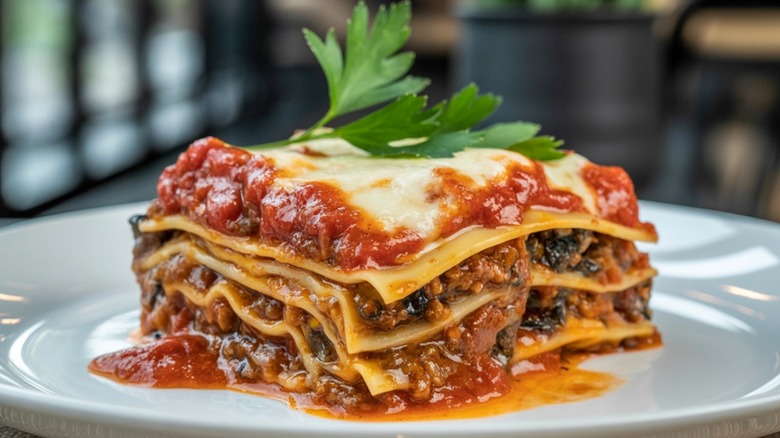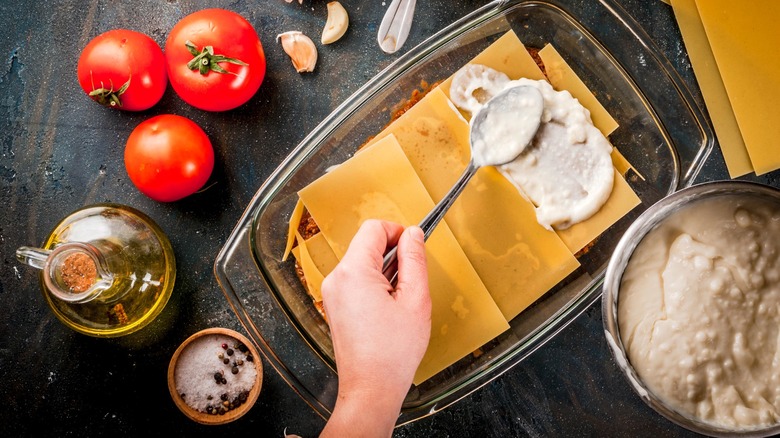Why Restaurant Lasagna Tastes So Much Better Than Homemade
We may receive a commission on purchases made from links.
People who frequent Italian restaurants are well aware that it's difficult to make homemade lasagna that tastes as exceptional as one cooked by a professional chef. So, what's the secret? Do restaurants make lasagna a day before serving it, or use special equipment that folks don't typically have at home? Or does a phenomenal lasagna come down to implementing sage advice from an Italian nonna on her secret sauce? As it turns out, it's all about making sure every component in the lasagna is of the highest quality, according to Jasper J. Mirabile Jr., chef and owner of Jasper's Restaurant and host of the radio show "Live! From Jasper's Kitchen."
Chef Mirabile contended that the backbone of any remarkable lasagna lies in using the right type of cheese and not rushing the sauce. "I believe there are two key ingredients that truly make the difference: the slow-cooked homemade Sunday sauce is really one of ours, and the ricotta cheese," he said. Sunday sauce can't just be slapped together at the last minute; it simmers over the better part of a day, melding tomato, garlic, and herbs to create a complex flavor that is simply unachievable in a shorter time.
Along with a slow-simmered sauce, a superb ricotta mixture is equally essential (It's been attempted, but cottage cheese won't cut it in lasagna). "You have to use a high-quality ricotta with rich flavor and low moisture," chef Mirabile said. "Adding eggs to the ricotta is just as important as it helps the cheese mixture rise beautifully, almost like a soufflé in between the layers of pasta, sauce, and meat."
Making restaurant quality lasagna at home
Incorporating a rich Sunday sauce and a ricotta-and-egg mixture into your lasagna sets you on the right path. Yet Jasper J. Mirabile Jr. insisted that those aren't the only factors that equate to a homemade lasagna that tastes like it was cooked in a restaurant. One thing he pointed out was that after being left to simmer throughout the day, the sauce can be enhanced with one minor addition. "Many Italians also like to mix béchamel sauce with tomato sauce, which gives the lasagna a wonderful texture," chef Mirabile said. A flavorful meat added to the sauce also raises the bar. "If you are using Italian sausage, make sure it is high quality and well seasoned, like the sausage we use at Jasper's."
Of course, going to all the trouble of making an exceptional Sunday sauce doesn't make much sense if you aren't layering a choice pasta into the dish. "Use a high-quality pasta sheet," chef Mirabile said. "We love Barilla thin pasta sheets because you do not even have to cook them, and they are so light." Barilla Oven-Ready Lasagne goes straight from the box to your baking dish — no boiling required.
Once the lasagna is constructed, all that's left is to bake it. Chef Mirabile noted, "Our restaurant might be a little different, but we love our brick ovens, and we keep them hot." However, he isn't under the impression that the average home cook has access to such a contraption. "The truth is, you don't need any special equipment because I've made the same lasagna at home," he said. The primary goal is that everything comes together as it should while baking, and chef Mirabile's last piece of advice addresses that. "Another key technique is to bake the lasagna slowly at 375 degrees Fahrenheit until the ricotta rises like a beautiful soufflé."

